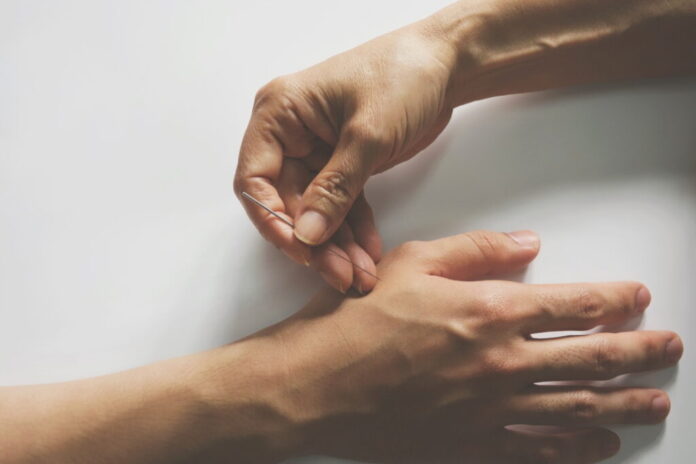Cleft points are useful for urgent care and acute symptoms
By Brandon SJ Oh, L.Ac.
There will not be rare cases for treating urgent symptoms in acupuncture clinics. For example, hitting a finger with hammer instead of a nail, a stomach pain after taking too much vitamin C on empty stomach, and one being kicked his testicles by other soccer players are the cases that a patient complains severe pain not required to call an ambulance. And if the patient visits emergency care, the treatment for the symptom is limited.
As an acupuncturist, we can use cleft points for immediate pain releasing and helping the patient calm down.
▲ Definition of Cleft Point
Cleft point literally means a space in between bones or muscles and stores a greater amount of Qi. Also, cleft points respond by enhancing blood and Qi circulation to a pathogen that causes the exterior syndrome.
It is required not to draw blood as a method of treatment from the cleft points. Because cleft points are the points where the meridian or channel Qi accumulates deeply. Therefore, drawing blood from the cleft points is prohibited.
Most acute symptoms cause immediate stagnation of Qi and blood on the meridian. Thus, the cleft point takes the role of resolving the stagnated Qi and blood on the meridian.
The cleft points tend to respond in susceptive ways toward an external syndrome. Moreover, the amount of tenderness of a cleft point represents the severity of the symptom. Therefore, the cleft points could be used as a diagnostic tool for an external syndrome. Especially, the cleft points are used to take care of various acute symptoms and bleeding.
The cleft points that belong to yang meridians used to treat muscular pain, and the cleft points on yin meridians indicate hemostasis.
There is a total of sixteen cleft points. Each of the twelve meridians, yang and yin heel vessel, and yang and yin link vessels have their cleft point.
The four cleft points that are belonged to extra meridians such as yang and yin heel vessels and yang and yin link vessel are usually used to take care of an acute symptom developed and staying on each extra meridian’s pathways. To explain it in detail, any chronic symptoms could develop an acute symptom; for example, chronic low back pain could be changed to sudden loss of sensation on the pain area, and in this case, cleft points could be used.
The cleft points that are belonged to extra meridians help Qi and blood circulation through their meridians.
Locations of the cleft points are lower than elbow and knee joints except for ST34, a cleft point of the stomach meridian. This makes ST34 to ST34 is considered as a coordinating acupuncture point.
Distortion could be treated by using cleft point. To use a cleft point, you have to find where distortion happened and where the place could belong to twelve meridians or four extra meridians.
If you find the right cleft point for the symptom, the treatment effect will be fast and effective.
▲ Indications of each cleft point
|
Ying, yang (陰陽) |
meridian |
Cleft point |
indications |
|
Hand Yin Meridians (手三陰) |
Lung |
LU6 |
coughing, hemoptysis, asthma, archorrhagia |
|
Pericardia |
PC4 |
palpitation, hiccup, chest pain, acute pleuritis |
|
|
Heart |
HT6 |
palpitation, neurosis, angina pectoris, epilepsy, insomnia |
|
|
Hand Yang Meridians (手三陽) |
Large Intestine |
LI7 |
Sore throat, facial palsy, toothache, hemorrhoid |
|
Triple Burner |
TE7 |
deafness, upper arm pain, heart pain |
|
|
Small Intestine |
SI6 |
Upper and low back pain, ear ringing |
|
|
Foot Yang Meridians (足三陽) |
Stomach |
ST34 |
Stomach pain, gastrorrhagia, upper stomach pain, acute mastitis, acute diarrhea |
|
Gall Bladder |
GB36 |
Pain in biliary tract due to cholelithiasis, hepatitis, epilepsy |
|
|
Urinary Bladder |
BL63 |
Epilepsy in childhood, abdominal muscle spasm, paraplegia |
|
|
Foot Yin Meridians (足三陰) |
Spleen |
SP8 |
Acute stomach pain, irregular menstruation, metrorrhagia, acute diarrhea |
|
Liver |
LR6 |
hepatitis, testicle pain, metrorrhagia |
|
|
Kidney |
K5 |
amenorrhea, menstrual pain, descensus uteri |
|
|
Heel Vessels (蹻脈) |
Yin Heel Vessel |
K8 |
Leg pain, testicle pain with swollenness, amenorrhea |
|
Yang Heel Vessel |
BL59 |
headache, low back pain, sciatica, paralysis |
|
|
Link Vessels (維脈) |
Yin Link Vessel |
K9 |
Bladder infection, nephritis, lower stomach pain with swollen testicles |
|
Yang Link Vessel |
GB35 |
headache, acute hepatitis, chest pain, leg paralysis |

































